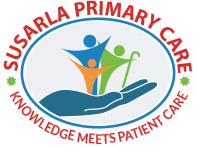Diabetes mellitus is one of the most common diagnoses made by family physicians. Uncontrolled diabetes can lead to blindness, limb amputation, kidney failure, and vascular and heart disease. Screening patients before signs and symptoms develop leads to earlier diagnosis and treatment, but may not reduce rates of end-organ damage.
Type 2 Diabetes is the most common type of diabetes.
What are the risk factors of Type 2 Diabetes?
- Family history
- Having a baby weighing more than 9 pounds
- Race
- Age
- Dark, thick, velvety skin appearing around the neck or armpits
- History of gestational diabetes
People who are African-American, Asian-American, Latino-Hispanic-American, Native American, or Pacific Islander all have a greater chance of developing type 2 diabetes than other groups.
Type 2 diabetes tends to occur in people age 45 years or older. This type of diabetes is occurring in younger people more and more, however.
Risk factors for type 2 diabetes that can be avoided include getting no exercise and being overweight or obese.
Risk factors:
- Obesity or being overweight, especially around the waist
- Getting little or no exercise
- High blood pressure
- Heart or blood vessel disease and stroke
- Low levels of “good” cholesterol (HDL)
- High levels of fats, called triglycerides
- Certain mental health conditions
- Polycystic ovary syndrome
- Smoking
- Stress
- Too much or too little sleep
How do you diagnose diabetes?
- Glycated hemoglobin (A1C) test. This blood test, which doesn’t require fasting, indicates your average blood sugar level for the past two to three months. It measures the percentage of blood sugar attached to hemoglobin, the oxygen-carrying protein in red blood cells.
- The higher your blood sugar levels, the more hemoglobin you’ll have with sugar attached. An A1C level of 6.5 percent or higher on two separate tests indicates that you have diabetes. An A1C between 5.7 and 6.4 percent indicates prediabetes. Below 5.7 is considered normal.
If the A1C test results aren’t consistent, the test isn’t available, or you have certain conditions that can make the A1C test inaccurate — such as if you’re pregnant or have an uncommon form of hemoglobin (known as a hemoglobin variant) — your doctor may use the following tests to diagnose diabetes:
- Random blood sugar test. A blood sample will be taken at a random time. Regardless of when you last ate, a random blood sugar level of 200 milligrams per deciliter (mg/dL) — 11.1 millimoles per liter (mmol/L) — or higher suggests diabetes.
- Fasting blood sugar test. A blood sample will be taken after an overnight fast. A fasting blood sugar level less than 100 mg/dL (5.6 mmol/L) is normal. A fasting blood sugar level from 100 to 125 mg/dL (5.6 to 6.9 mmol/L) is considered prediabetes. If it’s 126 mg/dL (7 mmol/L) or higher on two separate tests, you have diabetes.
- Oral glucose tolerance test. For this test, you fast overnight, and the fasting blood sugar level is measured. Then you drink a sugary liquid, and blood sugar levels are tested periodically for the next two hours.

